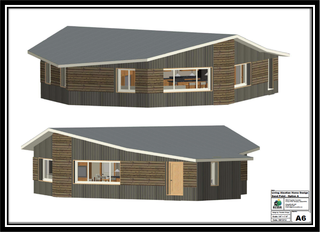Green Architecture Proves Challenging in the Aleutians

Friday, October 05 2012
Last year, the Aleutian Housing Authority challenged architects to design an affordable, net-zero energy home that could withstand the region’s hostile climate while adhering to the world’s strictest green building standards.
Not an easy task, but more than one hundred teams entered the contest. Trying to build the winning design though proved just how formidable a challenge AHA had posed.
“Bottom line is we ran into some elements with the design that were problematic," says AHA director Dan Duame.
A team of architects from Spain designed Finnesko, an aerodynamic house that channels wind like an airplane wing. The plan was to build the wind-powered house in Atka, a community with 60 permanent residents, but it turns out that’s not going to happen. Duame says Finnesko looked great on paper, but when it came to drafting construction plans, the problems piled up.
So AHA went back to the drawing board and developed a patchwork house that combines favorite elements from the contest submissions with a net-zero house design that’s been tested in Fairbanks.
"We were looking at that [the Fairbanks house] and talking about what we need and it just seemed to be a design that fit our purposes very well," Duame says.
The result is a 3-bedroom octagonal house with wood siding and a traditional roofline. It doesn’t scream cutting-edge architecture, but Duame hopes it will be revolutionary.
“It’s very risky, but it’s worth investing in. We can’t get to where we need to be by just doing the same thing over and over. The only way to get from point A to point wherever we’re headed is to take a little risk, put in a little money, do the best we can do and see what happens.”
So that’s what he’s doing. The Housing Authority is going to start building the house in Sand Point next summer. Duame says starting in a community with regular barge service will give AHA the opportunity to test the feasibility of the project before moving out to the region’s more remote communities.
Arlene Gundersen is a tribal administrator in Sand Point, for one of the groups the Housing Authority represents.
“Building it is going to cost a little bit more than the traditional home that we’ve been building out there. But we’re looking at trying to save the costs to the homeowner in the long-run.”
In hard numbers, the house is expected to cost between $300,000 and $400,000, but with possibility of saving thousands of dollars each year in utilities.
And that’s what it’s all about for Duame. Green architecture isn’t a means of saving the planet. It’s about saving money for rural Alaskans.
“If they [people] can’t afford to live there, they’re going to leave," he says" "And if they’re going to afford to live there, they’ve got to be able to pay the bills, particularly the energy bills."
In that sense, the project is test run for the future of green building. As fuel costs rise elsewhere in the country, energy-saving construction may start to look more attractive, and if Duame can prove that it’s cost-effective to construct living buildings in the country’s most remote, weather-beaten area, then it can be done anywhere.



